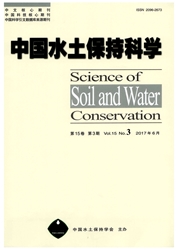

 中文摘要:
中文摘要:
侵蚀沟的演变是东北水土流失过程的重要方面。利用1968和2009年亚米级遥感影像,获取典型黑土区村级尺度的侵蚀沟分布、耕地垄向和土地利用数据,基于1∶1万地形图获取等高线、坡度、坡长和垄向坡度数据,在地理信息系统和遥感技术的支持下,分析典型黑土区41 a村级尺度侵蚀沟的动态变化及其影响因素。结果表明:1)41 a间,典型黑土区侵蚀沟密度有明显增加的趋势,基于分辨率为亚米级遥感影像解译的侵蚀沟密度较以往研究结果大幅增加;2)自然坡度0.25°~1.5°范围内为该区域侵蚀沟密度变化最大的区域,8°以上区域由于实施退耕还林措施,侵蚀沟密度降低;3)300~500 m坡长区域侵蚀沟密度出现极值;4)由于实施改垄措施,41 a后垄向坡度在0~0.25°范围内耕地面积增加,大于0.25°范围内耕地面积均减少。
 英文摘要:
英文摘要:
The aggravation of gully erosion represents the severity of water and soil loss in the typical black soil area in northeast China.Slope steepness and tillage are important natural and artificial factors that affect the evolution of gully erosion,respectively.Applying high spatial resolution remote sensing data is a useful method in the identification of the distribution and evolution of erosion gully.The distribution and density of erosion gully,ridge direction as well as land use of the village-scale in the year 1968 and 2009 were collected from two submeter remote sensing images by GIS and RS technologies,and the topographical data of corresponding areas such as contour,slope steepness,slope length and slope steepness along direction of ridge were extracted from the 1∶10 000 relief map.The dynamic of erosion gully and its driving factors during the passed 41 years were analyzed by Arcgis spatial analysis function.The results showed: 1) the density of erosion gully markedly increased during the past 41 years.The density of erosion gully from remote sensing interpretation by submeter resolution was much higher than that on previous lower resolution remote sensing data;2) The largest variation area of erosion gully density was found in the region of slope steepness between 0.25°and 1.5°,while the density of erosion gully decreased in the area of slope steepness more than 8°due to reforestation;3) The highest density of erosion gully was found in the zone of slope length between 300 m and 500 m of the slope;4) During the recent 41 years,the cultivated area increased in the region of gradient along the ridge between 0 and 0.25° after ridge direction was changed,whereas it decreased in the region of slope steepness larger than 0.25°.
 同期刊论文项目
同期刊论文项目
 同项目期刊论文
同项目期刊论文
 期刊信息
期刊信息
